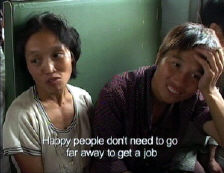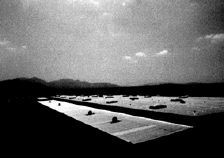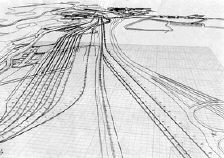From the Open-Publishing Calendar
From the Open-Publishing Newswire
Indybay Feature
The People's Republic art exhibit
Inspired by “The Rise of the Fortress Continent,” a Naomi Klein article published in The Nation, Rupert Jenkins and Natasha Garcia-Lomas collected works of art from 5 nations exploring the effects of often-exploitive free trade agreements on laborers and their indigenous cultures.

Sitting alone in a dark, cavernous alcove, surrounded by the blank walls and smooth, cement floor of the San Francisco Arts Commission Gallery, an appreciation of my own space and spirit overwhelmed me as I watched Ning Ying’s documentary, Railroad of Hope. The film begins in a train station filled with endless, crushing lines and follows the hordes of Sichuan peasants traveling to Xinjiang for work during the cotton harvest. Many of the anxious villagers have never been on a train or away from home, but they are cram like cattle onto train cars for the hope of paying jobs at the end of the line.
Ying strives to humanize these workers who have been torn from their homes and families, by asking them about their dreams and goals, but their souls have been so repressed by the cog-in-the-system mentality that the government has forced upon them, that their answers are devastatingly tragic. When asked what she wants to be, one little girl finally replies “wage worker” and then bursts into tears. A tiny, shirtless boy is asked his favorite wish, and he answers, “That the trains weren’t so crowded.” A teenager is asked what his dreams, goals, or hopes are, but he can’t answer any of these questions. He tries, but his voice is lost, and he stares out the window, as the barren Gobi desert rushes past, and the film ends abruptly, but perfectly, before the peasants ever make it to their destination.
Railroad of Hope is one of six works showing until May 29 as part of “The People’s Republic” exhibition, the first of a two-part series dealing with globalization-influenced art. Inspired by “The Rise of the Fortress Continent,” a Naomi Klein article published in The Nation, Rupert Jenkins and Natasha Garcia-Lomas collected works from 5 nations exploring the effects of often-exploitive free trade agreements on laborers and their indigenous cultures. According to Klein, a fortress continent is “a block of nations that joins forces to extract favorable trade terms from other countries, while patrolling their shared external borders to keep people from those countries out.”
The stark amorality of this concept is illustrated by Sergio de la Torre’s sterile, solemn photos of maquiladoras, or Mexican border factories, and by Stefan Gec’s animated video installation depicting a rotating blueprint of the Chunnel, which connects Great Britain with continental Europe. Since both maquiladoras and the Chunnel were created to brim with inhabitants, albeit transitory ones, an eerie sense of vacancy and removal haunts both of these black and white pieces.
Eric Beltran and Alejandro Magallenes inject a bitter humor into “The People’s Republic” with a series of confusingly-arranged, overlapping posters trumpeting the empty, NAFTA-era promises of George H.W. Bush and former Mexican President Carlos Salinas de Gortari. The light-hearted predictions of prosperity read like epitaphs of a dead joke, considering the current economic despair that still grips many workers south of the border.
Best illustrating how the profit motive of the fortress continent concept ignores the human wreckage at the core of these economies is Crossing Surda (A Record of Going to and from Work). Emily Jacir simply hid a video camera in her bag and documented her daily commute from the Palestinian-controlled Ramallah to Bir Zeit, a university town under Israeli occupation, but the landscape of her kilometer-long walk is a shaky glimpse into a hellish terrain of tanks, rubble, soldiers and barbed-wire. Jacir’s walk along this gritty, industrial road would be an apt metaphor for the ongoing trudge of impoverished nations towards the supposed promised land of the free market global economy, but Jacir knew where she was going, whereas for these nations, there is no destination in sight.
Admission is FREE, 401 Van Ness (across from City Hall), Wed.-Sat., 12-5 p.m., 554-6080
Part two of this series, Global Priority, runs from June 17-August 14 and will feature the work of over 50 artists from around the world
Ying strives to humanize these workers who have been torn from their homes and families, by asking them about their dreams and goals, but their souls have been so repressed by the cog-in-the-system mentality that the government has forced upon them, that their answers are devastatingly tragic. When asked what she wants to be, one little girl finally replies “wage worker” and then bursts into tears. A tiny, shirtless boy is asked his favorite wish, and he answers, “That the trains weren’t so crowded.” A teenager is asked what his dreams, goals, or hopes are, but he can’t answer any of these questions. He tries, but his voice is lost, and he stares out the window, as the barren Gobi desert rushes past, and the film ends abruptly, but perfectly, before the peasants ever make it to their destination.
Railroad of Hope is one of six works showing until May 29 as part of “The People’s Republic” exhibition, the first of a two-part series dealing with globalization-influenced art. Inspired by “The Rise of the Fortress Continent,” a Naomi Klein article published in The Nation, Rupert Jenkins and Natasha Garcia-Lomas collected works from 5 nations exploring the effects of often-exploitive free trade agreements on laborers and their indigenous cultures. According to Klein, a fortress continent is “a block of nations that joins forces to extract favorable trade terms from other countries, while patrolling their shared external borders to keep people from those countries out.”
The stark amorality of this concept is illustrated by Sergio de la Torre’s sterile, solemn photos of maquiladoras, or Mexican border factories, and by Stefan Gec’s animated video installation depicting a rotating blueprint of the Chunnel, which connects Great Britain with continental Europe. Since both maquiladoras and the Chunnel were created to brim with inhabitants, albeit transitory ones, an eerie sense of vacancy and removal haunts both of these black and white pieces.
Eric Beltran and Alejandro Magallenes inject a bitter humor into “The People’s Republic” with a series of confusingly-arranged, overlapping posters trumpeting the empty, NAFTA-era promises of George H.W. Bush and former Mexican President Carlos Salinas de Gortari. The light-hearted predictions of prosperity read like epitaphs of a dead joke, considering the current economic despair that still grips many workers south of the border.
Best illustrating how the profit motive of the fortress continent concept ignores the human wreckage at the core of these economies is Crossing Surda (A Record of Going to and from Work). Emily Jacir simply hid a video camera in her bag and documented her daily commute from the Palestinian-controlled Ramallah to Bir Zeit, a university town under Israeli occupation, but the landscape of her kilometer-long walk is a shaky glimpse into a hellish terrain of tanks, rubble, soldiers and barbed-wire. Jacir’s walk along this gritty, industrial road would be an apt metaphor for the ongoing trudge of impoverished nations towards the supposed promised land of the free market global economy, but Jacir knew where she was going, whereas for these nations, there is no destination in sight.
Admission is FREE, 401 Van Ness (across from City Hall), Wed.-Sat., 12-5 p.m., 554-6080
Part two of this series, Global Priority, runs from June 17-August 14 and will feature the work of over 50 artists from around the world


Add Your Comments
We are 100% volunteer and depend on your participation to sustain our efforts!
Get Involved
If you'd like to help with maintaining or developing the website, contact us.
Publish
Publish your stories and upcoming events on Indybay.
Topics
More
Search Indybay's Archives
Advanced Search
►
▼
IMC Network


